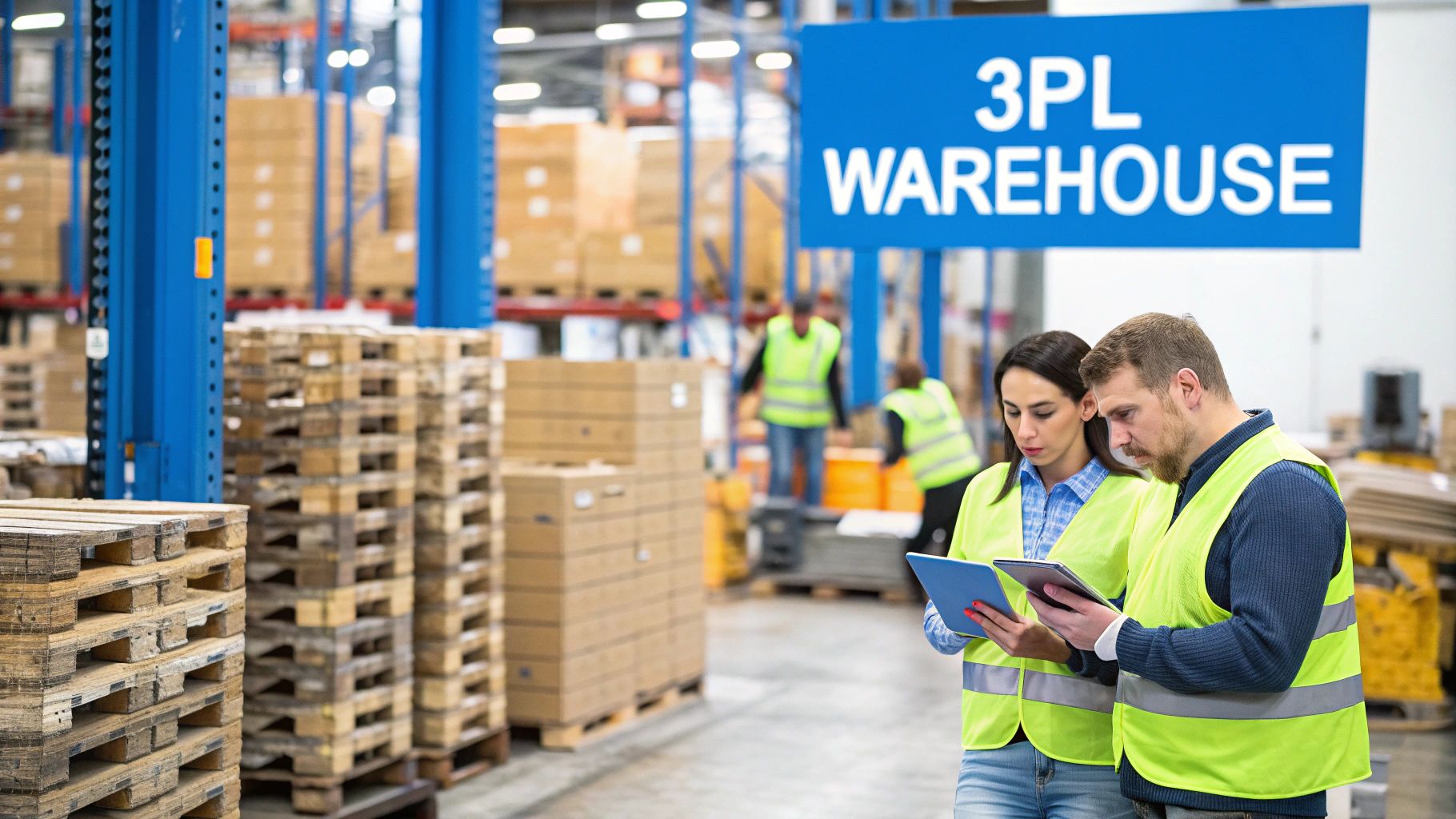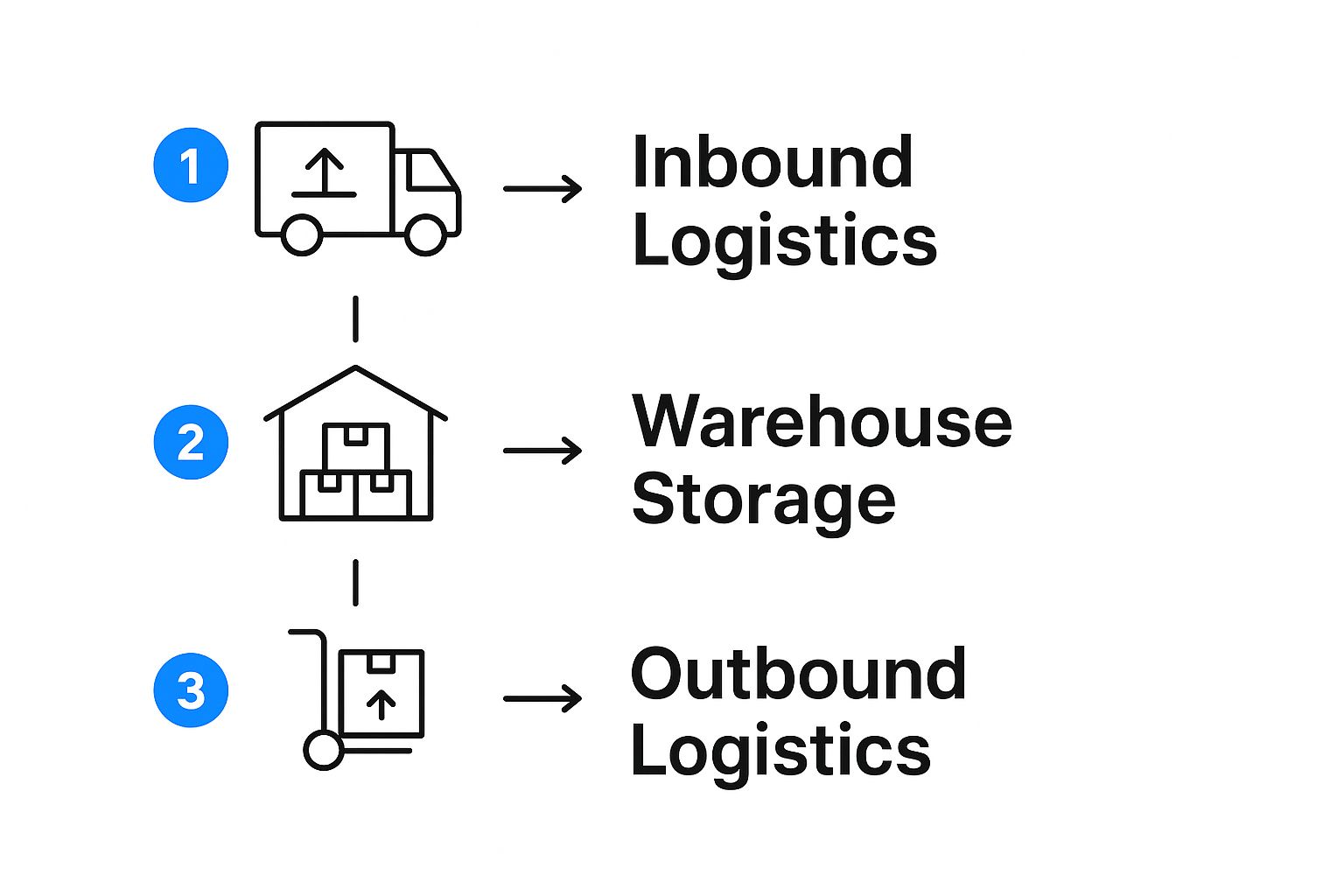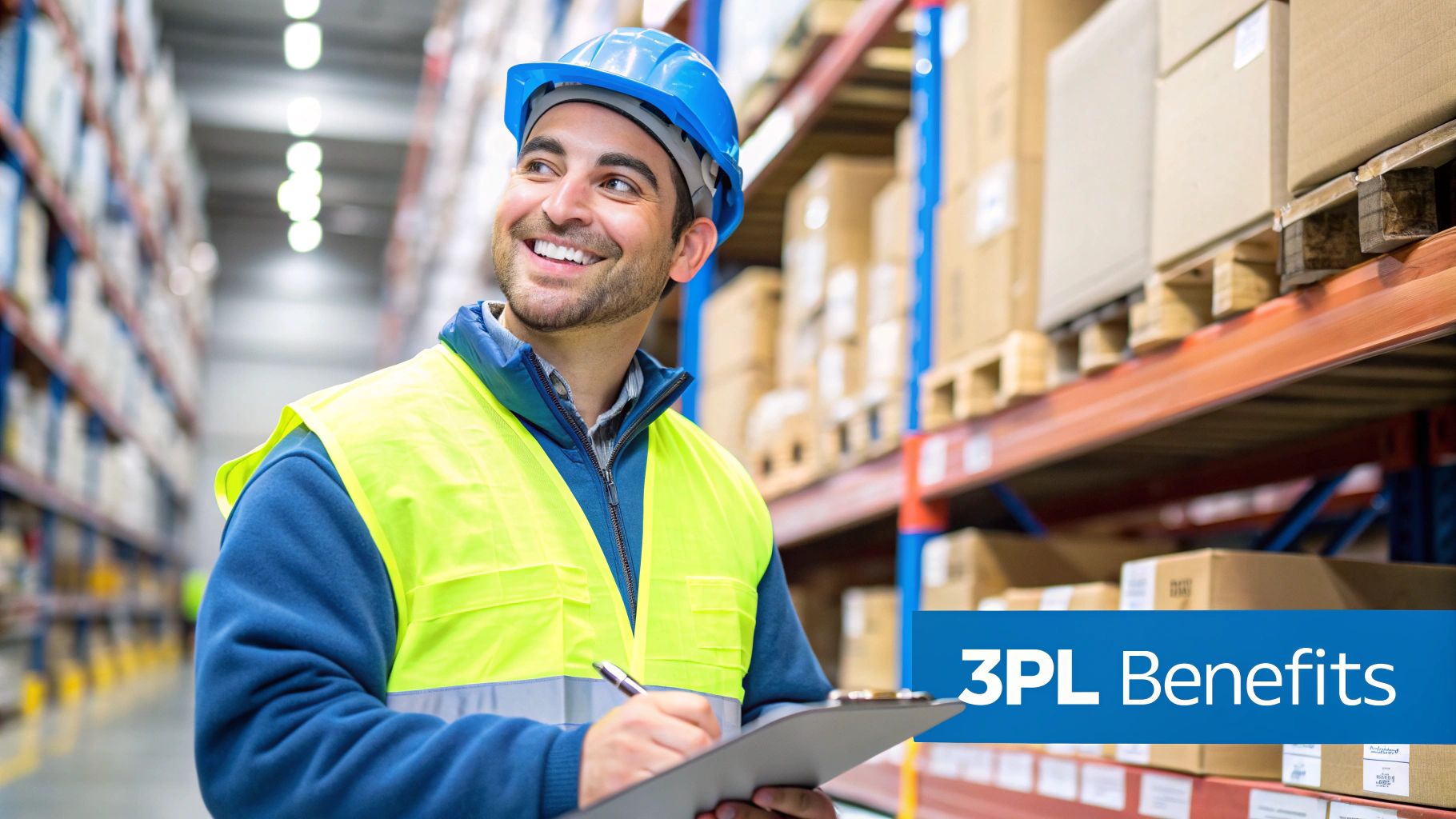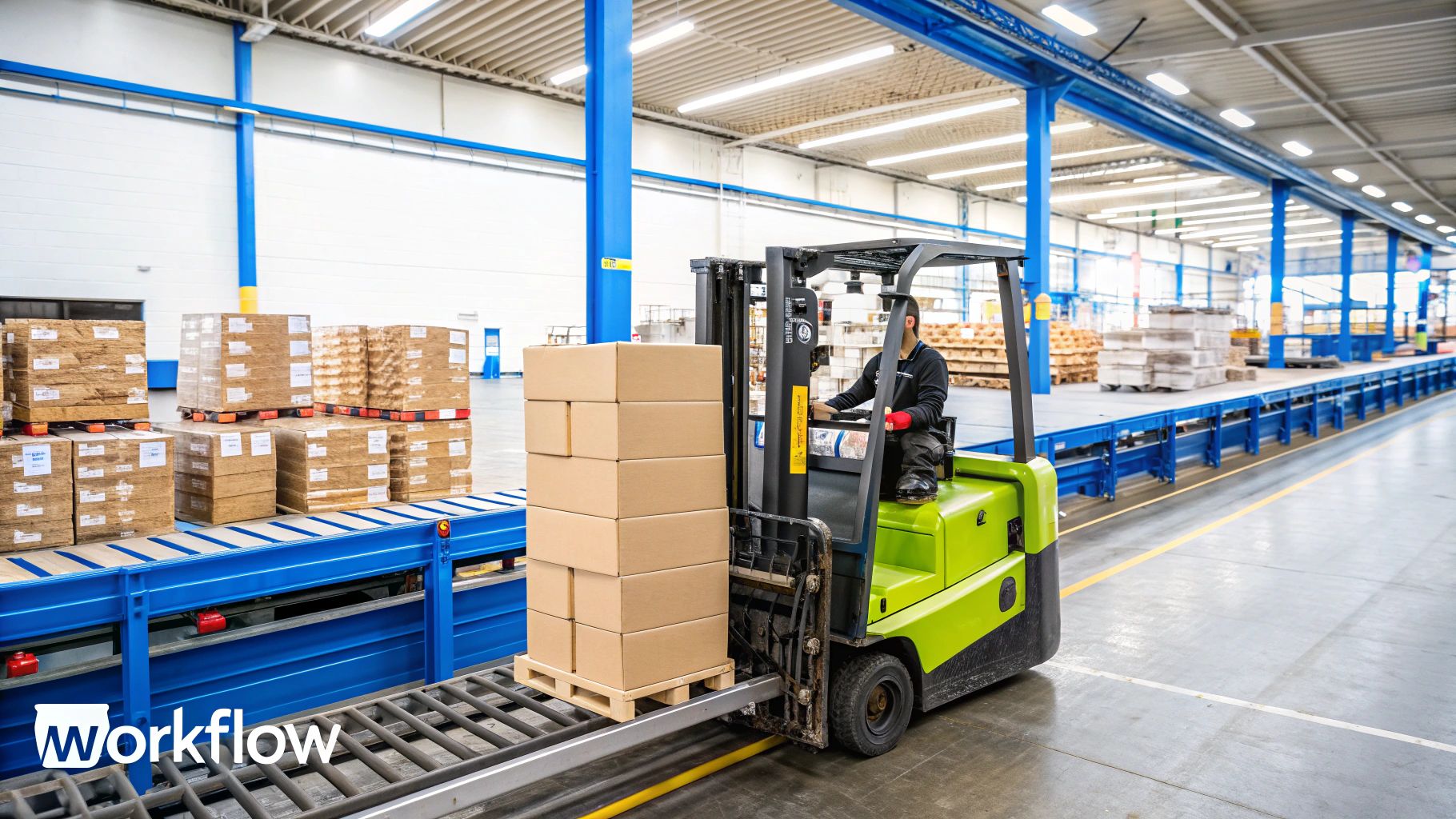Think of a 3PL warehouse as the mission control for your brand's physical products. It’s not just a place to stash boxes; it’s a strategic partner that takes on the complex, time-consuming work of storing inventory, fulfilling orders, and managing shipping so you don't have to.

The concept is simple but powerful. Instead of sinking your capital into renting a massive building, hiring a warehouse team, and buying expensive equipment, you outsource all of it to an expert. This move frees you up to focus on what you do best: developing amazing products, crafting killer marketing campaigns, and actually growing your brand.
It's a model that works for everyone, from ambitious startups just getting off the ground to established companies looking for an edge. A 3PL is far more than just four walls and a roof; it's a growth engine. The United States is home to approximately 72,937 third-party logistics businesses, creating a vibrant ecosystem of providers ready to help brands scale.
These aren't just empty sheds. Modern 3PLs are full-service operations that can handle everything from small retail goods to bulky items, often serving multiple industries at once.
So, what does a 3PL actually do day-to-day? Their work can be broken down into four essential functions that keep your supply chain humming along smoothly. Each step is meticulously designed to get your products into your customers' hands quickly and accurately.
The table below gives a quick snapshot of these key services and what they mean for your business.
By taking these fundamental (and often tedious) tasks off your plate, you gain instant access to expert processes, cutting-edge technology, and operational scale without the massive upfront investment.
At its heart, a 3PL warehouse provides dedicated storage and robust logistics, but it's important to understand this within the broader context of different types of business storage solutions. For an eCommerce brand, however, a 3PL offers a uniquely integrated solution that directly fuels growth.
Ever wondered what actually happens inside a 3PL warehouse after your inventory arrives? It’s not just chaos and forklifts. The whole process is a carefully orchestrated dance between smart technology and expert human handling.
Let's pull back the curtain and follow one of your products from the moment it hits the loading dock to the second it’s on its way to a happy customer.
The journey starts with what the industry calls inbound logistics, or simply, receiving. When your inventory shows up, it's not just tossed onto a random shelf. The warehouse team meticulously unloads the shipment, inspects every item for damage, and confirms the count against your shipping manifest. Getting this first step right is critical for keeping your inventory records accurate from day one.
Once everything is checked and verified, each product is scanned into the 3PL’s Warehouse Management System (WMS). Think of this powerful software as the brain of the entire operation. It gives both you and the 3PL a real-time, bird's-eye view of your stock levels. Every single item or pallet gets assigned a specific storage location, making sure it can be found instantly when an order comes through.
This visual breaks down the core stages of that logistics flow.

As you can see, the product's life in the warehouse is a clear progression. It moves from receiving to strategic storage, and finally, out the door for shipping.
Next up is storage. Your products are strategically placed in bins, on shelves, or on pallets based on their size, weight, and how often they sell. This isn't random. It’s a science designed to make the next stage—fulfillment—as fast and efficient as possible.
The real magic happens when a customer clicks "buy." That order from your online store is instantly zapped over to the 3PL's WMS, which then generates a "pick list" for the warehouse crew.
An efficient pick-and-pack process is the heart and soul of customer satisfaction. A recent study found that 62% of online shoppers say fast shipping speeds are what makes for a positive experience. That speed starts the very moment an item is picked from the shelf.
To get it done quickly, warehouse associates use optimized methods like batch picking (grabbing items for multiple orders at once) or zone picking (where each person is responsible for a specific area of the warehouse).
After an item is picked, it’s whisked away to a packing station. Here, another expert takes over, securely packing the products into the right-sized box with the proper dunnage (like air pillows or packing paper) to keep things safe in transit. This step is also key for managing your shipping costs, since dimensional weight is a huge factor in what carriers charge.
Finally, the packed box is weighed, a shipping label is printed, and it's sorted for carrier pickup. Most 3PLs have daily pickups scheduled with all the major players like USPS, FedEx, and UPS. As soon as the carrier scans that package, tracking information is automatically pushed to your e-commerce platform and sent straight to your customer.
Grasping how a product moves through a 3PL often helps to know the basics of logistics. For a deeper dive, this practical guide on how to ship freight is a great resource. It's this seamless, high-touch process that ensures your brand's promise is delivered directly to your customer's doorstep.

The best 3PLs have moved far beyond the old model of just storing and shipping products. Today, they act as a true extension of your brand, offering specialized services that solve complex operational headaches and create the kind of customer experiences that build loyalty.
These value-added services are what really separate a basic logistics provider from a genuine growth partner. They're the secret sauce that can make your operations more efficient and your brand more memorable.
Think about how you sell your products. Do you ever run promotions like a "starter kit" or a "buy two, get one" deal? A great 3PL can take care of the kitting and assembly for you. They’ll physically combine individual items into a single, ready-to-ship unit, meaning your customers get that perfect bundle without you ever having to touch the inventory yourself.
Many of today's most successful businesses rely on unique fulfillment models that a standard warehouse simply isn't equipped to handle. A capable 3PL partner offers solutions built specifically for these needs.
Key Insight: Thinking of returns as just a cost center is an outdated view. A seamless returns process is now a critical part of the customer journey. Getting it right can seriously boost customer retention and your brand's reputation, making it a powerful competitive edge.
Beyond the customer-facing perks, a top-tier 3PL brings serious operational advantages that directly impact your bottom line. These advanced capabilities show a much deeper level of partnership.
One of the most powerful is cross-docking. It’s a slick logistics maneuver where incoming products are unloaded from a truck and almost immediately loaded onto an outbound truck, spending little to no time in storage. It’s perfect for moving high-demand inventory at lightning speed, slashing storage costs and shortening delivery times.
Many 3PLs also get into freight management, helping you negotiate better shipping rates and coordinate complex shipments. Some even offer data-driven inventory forecasting, using your sales history to help you make smarter stocking decisions.
Getting familiar with these services is crucial. When you start looking for a partner, knowing what’s possible helps you separate the basic warehouses from the strategic powerhouses. To help you make the right choice, we’ve put together a comprehensive guide on what a 3PL company is and tips to select the best one. Finding a partner with these advanced skills can help you finally tackle those operational challenges that once seemed impossible, clearing the path for real, sustainable growth.
Choosing to partner with a 3PL warehouse isn't just about handing off boxes. It’s a strategic move that delivers real, measurable gains for your business, letting you compete on a level you couldn't reach on your own. By outsourcing your logistics, you unlock huge advantages in cost, scale, and expertise.
Let's start with the most obvious win: cost savings. Think about the mountain of cash needed to run your own warehouse. You'd have to lease a massive space, hire and train a full team, buy forklifts and packing stations, and sink money into a complex Warehouse Management System (WMS). A 3PL wipes all those massive upfront expenses off the table, turning them into a predictable monthly cost.
But the savings don't stop there. 3PLs ship staggering volumes every single day. This gives them serious negotiating power with carriers like FedEx, UPS, and USPS, letting them lock in shipping rates far lower than what a single business could ever dream of. Those discounts are passed directly to you, chipping away at your cost per order.
One of the biggest headaches for a growing ecommerce brand is dealing with swings in demand. A killer Black Friday sale or a product going viral on TikTok can triple your order volume overnight. If you're fulfilling in-house, that kind of spike means chaos, shipping backlogs, and a wave of angry customers.
This is where a 3PL partner truly shines, giving you the flexibility to scale effortlessly. They already have the warehouse space, the trained staff, and the proven systems to absorb those demand spikes without even breaking a sweat.
This on-demand scalability means you can chase aggressive growth goals with total confidence, knowing your operational backbone is solid. Figuring out the perfect time to make this move is crucial, and our guide on when to use a 3PL can help you spot the tell-tale signs for your brand.
Finally, partnering with a 3PL instantly gives you access to a team of logistics pros and their battle-tested systems. These experts live and breathe efficiency, constantly tweaking their workflows to pick, pack, and ship orders faster and with fewer errors. Their expertise becomes your competitive advantage. The global 3PL market is projected to hit a value of $1.4 trillion by 2025, which shows just how vital these providers have become. On top of that, sustainability is a growing focus, with over 66% of providers now building green logistics into their services to meet consumer expectations. Find out more about these 3PL market trends on ClickPost.ai.
By offloading logistics, you free up your most valuable resource: your time. Instead of managing warehouse staff or troubleshooting shipping issues, you can focus on the activities that truly drive growth—marketing, product innovation, and building your brand.

Choosing a 3PL partner is one of the biggest decisions you'll make for your eCommerce brand. This isn't just about renting shelf space; you're handing over your physical products and trusting another company to represent your brand with every single order they ship.
Getting this relationship right is make-or-break for growth. It requires a clear, methodical approach that goes way beyond a simple price comparison. You need a partner whose capabilities truly align with your brand’s specific needs, both for today and for where you plan to be tomorrow.
First things first: technology. A modern 3PL runs on its Warehouse Management System (WMS), and it absolutely must connect flawlessly with your eCommerce platform. Whether you're on Shopify, WooCommerce, Amazon, or another storefront, this integration needs to be seamless.
This shouldn't be some clunky, manual process that requires daily check-ins. You're looking for real-time, two-way sync for orders, inventory levels, and tracking information. A unified dashboard where you can see everything in one place is a massive advantage, helping you prevent stockouts and stay in complete control of your operations.
Where a 3PL stores your inventory has a direct and immediate impact on your shipping costs and delivery speeds. A partner with a single warehouse might seem fine if all your customers are clustered in one region. But for a brand with a national customer base? A distributed network is a game-changer.
Strategic Placement: A network of strategically located warehouses allows you to split your inventory across the country. This simple move shrinks the distance each package has to travel, which means lower shipping costs for you and faster delivery times for your customers—a huge competitive advantage.
Not all products are created equal, and not all 3PLs can handle every type of item. You have to ask: does the 3PL have proven, hands-on experience with products like yours? This is a non-negotiable.
Finding a partner who already understands the unique challenges of your product category prevents costly mistakes and ensures your inventory gets the care it deserves. Making a smart choice upfront is vital, and you might want to consider 3PL for your ecommerce fulfilment for these specialized reasons alone.
Finally, you need absolute clarity on their pricing model. Don't be shy about asking for a complete breakdown of all potential fees—receiving, storage, pick-and-pack, and any onboarding costs. A transparent partner will be upfront about their pricing, helping you make a confident and informed decision without any surprises down the road.
The world of logistics is changing faster than ever. The 3PL warehouse of tomorrow isn't just a big building stacked with boxes; it's becoming an intelligent hub, wired with technology built to keep up with our ever-growing demand for speed and accuracy. This whole shift is being powered by some incredible new tools that are already fundamentally changing how supply chains work.
At the heart of this transformation are artificial intelligence (AI) and machine learning. Instead of just looking at last year's sales numbers, modern 3PLs are using AI to digest everything from market trends and social media buzz to local weather forecasts. The result? Uncannily accurate predictions that help prevent frustrating stockouts during peak seasons and slash the costs of carrying too much inventory.
Automation is the other major force shaping the warehouse of the future. The days of workers walking for miles down endless aisles are numbered, as smart robotics step in to handle the heavy lifting and repetitive tasks.
Looking even further ahead, the evolution of 3PLs is tied directly to things like automation in packaging, where machines will ensure every single item is packed perfectly for its journey.
This wave of technology is also changing the very layout of the logistics map. To satisfy the public’s fierce appetite for instant gratification, the entire industry is being forced to adapt.
By the mid-2020s, the 3PL sector has been rapidly adapting to meet ultra-fast delivery expectations. Statistics show that roughly 80% of U.S. consumers now expect same-day delivery, a demand that has forced a strategic pivot.
This pressure cooker environment has given rise to a new concept: the micro-fulfillment center. By setting up these smaller, urban warehouses much closer to where customers actually live, 3PLs can make same-day delivery not just a possibility, but a profitable reality. These are the kinds of innovations building a smarter, more resilient supply chain for everyone.

Even after getting a handle on what a 3PL warehouse does, you probably still have some practical questions running through your mind. It’s completely normal. This section is here to give you straight answers to some of the most common uncertainties we hear from e-commerce founders.
One of the biggest points of confusion is the difference between a 3PL and a freight forwarder. Think of it this way: a freight forwarder is like a travel agent for your cargo, simply arranging its trip from point A to point B. A 3PL, on the other hand, is your entire logistics department—they store your inventory, pick and pack every order, and manage the final shipment to your customer's door.
So what should you expect when it comes to contracts? This definitely varies. Many 3PLs offer flexible month-to-month agreements, which are perfect for growing brands that need to stay nimble. Others might propose 1–3 year contracts, which often come with better pricing if you’re ready for a longer commitment. The key is to always clarify the terms before you sign anything.
And what about getting your inventory ready for its first trip to a 3PL warehouse? This is where a little prep work goes a long way.
Key Takeaway: A successful 3PL partnership is built on a foundation of solid preparation. When you communicate clearly and make sure your inventory is labeled correctly, you empower your provider to work efficiently from day one, which helps you avoid costly delays and mistakes down the road.
Getting these final details right is often what separates a good partnership from a great one. For a complete look at the entire process, feel free to check out our complete guide to third-party logistics.
Ready to stop worrying about logistics and start focusing on growth? Simpl Fulfillment provides the reliable, end-to-end fulfillment that lets your brand shine. See how our same-day shipping and dedicated support can elevate your business at https://simplfulfillment.com.